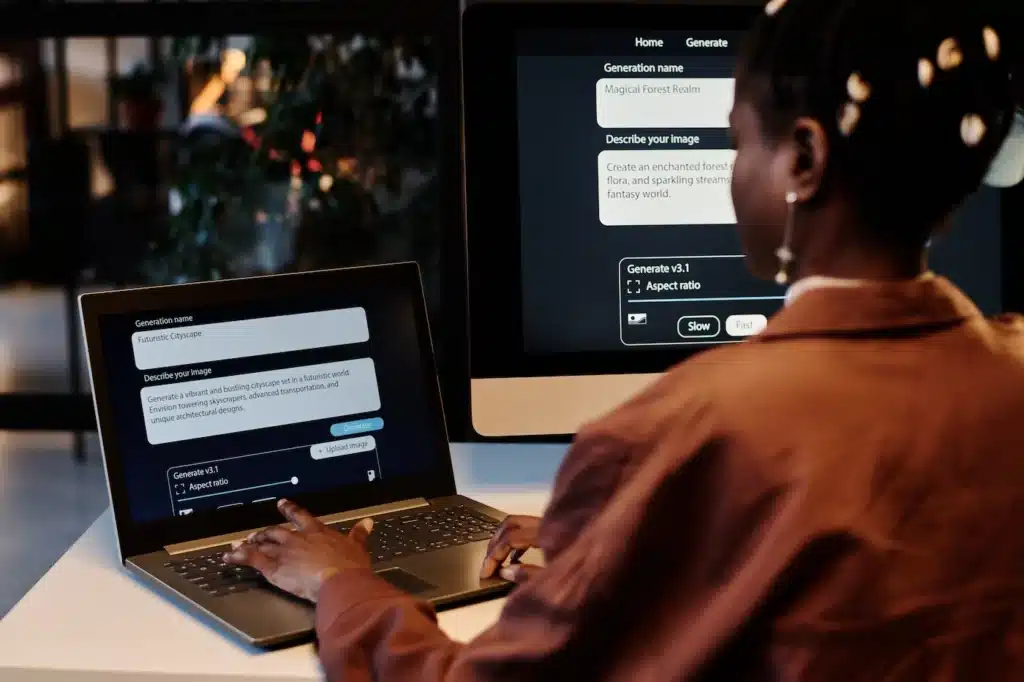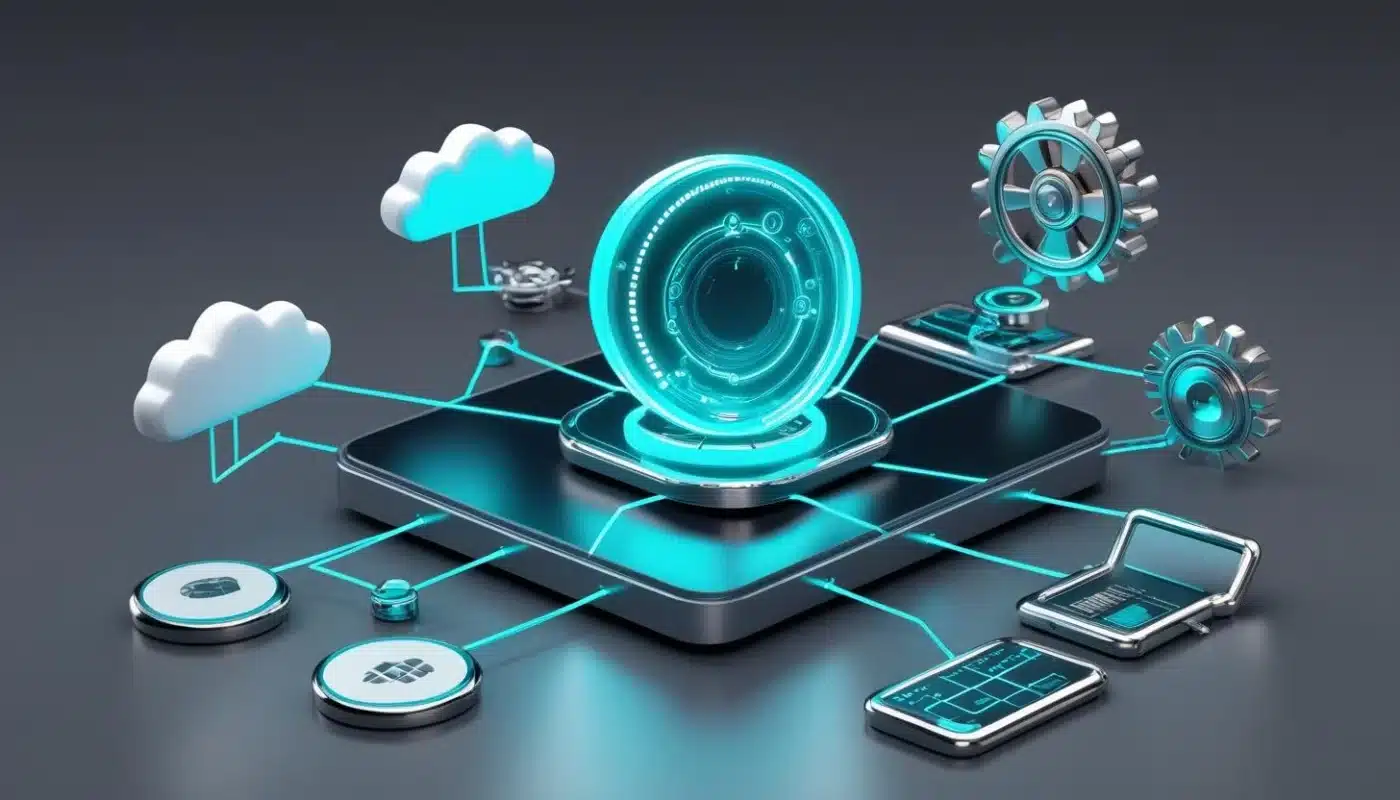How do you choose the right type of chatbot to automate your business processes?
Use concrete examples to discover the differences between a generalist LLM chatbot and a specialized chatbot (via fine-tuning or RAG). What real impact can it have on your business in terms of user experience, automation and return on investment?
In this article, take a look at our table of tasks that can be automated with a chatbot, by profession!
Understanding the types of AI chatbots: generalist or specialist, which to choose according to your objectives?
Automate interactions, increase efficiency, personalize the user experience: a chatbot can meet a number of objectives… it’s just a question of choosing the right type!
Two main categories of chatbots automate tasksusing LLM models. These artificial intelligence models are trained on billions of texts to understand, generate and summarize human language in a fluid, contextual way. They form the conversational engine at the heart of modern AI agents.
In simple terms, there are two types of AI sculpins:
- The generalist chatbot (or LLM base without adaptation);
- The specialized chatbot (via fine-tuning/RAG)
There is a third, hybrid type of chatbot. It combines the power of general-purpose LLMs with advanced techniques for prompting, agent orchestration or dynamic contextual tooling.
General-purpose LLM chatbot: definition and use cases
This type of chatbot uses a pre-trained language model(such as GPT) as is, without any specific adaptation. It understands and responds fluidly, but its answers remain general, not always adapted to your business or internal data.
Specialized LLM chatbot: tailor-made AI for your industry
This chatbot is based on the same model. With AI, it is notably customizable thanks to two techniques:
- Fine-tuning, which adjusts the model to specific internal data
- RAG (Retrieval-Augmented Generation), which enables the chatbot to fetch answers from specific document databases in real time.
It’s much more precise and contextual. This is the type of chatbot with which you can automate tasks specific to your business.

Choosing between a specialized or general chatbot
It all depends on your objectives when choosing between these two types of chatbots, for example:
- Answer everything with great flexibility: generalist chatbot;
- Automate a business (HR, customer service, legal, IT) with precision: specialized chatbot (RAG or fine-tuning);
- Reduce customer support time: specialized chatbot;
- Rapid prototyping without a backend: general chatbot;
- Ensure access to reliable internal data: specialized chatbot with RAG.
The 5 strategic benefits of a specialized chatbot for your company
Using this type of customized automation technology is very useful for repetitive actions, and in particular for adapting them to actual task specifications!
Day-to-day operations essential to the smooth running of a department (e.g., responding to HR requests, tracking orders, managing IT tickets) can be intelligently automated thanks to a context-sensitive, personalized solution connected to your internal tools.
Here are the 5 strategic benefits of a personalized chatbot for a company:
- Lower processing costs;
- Improved first contact resolution rate ;
- Faster processing cycles (HR, after-sales service, orders) ;
- Standardization of business responses ;
- Measurable ROI in just a few weeks.
Example of HR automation: simplifying internal administrative requests with a chatbot
In any organization, administrative and HR departments are regularly called upon to deal with recurring internal requests, which are often time-consuming for their teams. Among the most frequent are :
- Vacation requests (paid leave, RTT, exceptional absences)
- Generation of certificates (of work, salary, attendance)
- Questions related to employee benefits (mutual insurance, teleworking, RTT)
- Search or send HR forms (expense reports, authorizations, onboarding)
It’s possible to automate all these tasks via an LLM chatbot specialized in HR, connected to your internal systems (HRIS, intranet, HR database). Integrated in this way, this virtual assistant can :
- Instantly answer questions on internal company policies;
- Automatically generate personalized administrative documents;
- Guide users through the process (e.g., how to request exceptional leave);
- Send completed forms directly to the right department or to the employee area.

E-commerce example: automating the management of after-sales requests via a chatbot
On an e-commerce platform, for example, after-sales management can quickly generate a large volume of repetitive requests. These are often time-consuming for support teams, such as :
- Order status tracking (shipment, delivery, delay) ;
- Managing product returns or exchanges;
- Check the availability of an item in real time;
- Handling simple complaints (damaged product, order error, refund request).
With a specialized LLM chatbot, you can automate these tasks! It can even be connected to your logistics system (ERP, e-commerce CMS, CRM). Connected to ERP and customer service, this virtual assistant can :
- Check order status in real time ;
- Generate a return label according to the customer’s policy ;
- Propose an alternative product if stock is exhausted;
- Trigger an after-sales service request without the need for a human agent.
Automate tasks by professional sector
The pro sectors that can benefit most from an AI chatbot are going to be restaurants, e-commerce, technical support and human resources :
- For the restaurant sector: a specialized chatbot will automate tasks related to online reservations, customer flow management and satisfaction thanks to a digitalized customer serviceexperience ;
- For e-commerce: a business chatbot automates product recommendations, stock management and the purchasing tunnel, optimizing e-commerce conversion and the average basket;
- For technical support: an IT support chatbot automates incident diagnosis, ticket processing and user log feedback, reducing resolution time by proactively managing IT requests;
- For human resources: an HR chatbot handles the automation of leave, onboarding and internal FAQs, accelerating HR digitization.
Next come the sectors :
- For B2B software support: an automated virtual assistant analyzes errors and triggers ITSM tickets, for faster turnaround times thanks toautomated technical support ;
- For financial and banking services: an AI chatbot automates assistance with routine operations and the provision of personalized advice for an omnichannel customer experience ;
- For the insurance sector: an intelligent chatbot simplifies claims declarations and automatically generates quotes toautomate insurance processes ;
- For the healthcare sector: a medical chatbot automates appointment booking and symptom sorting, freeing up time for practitioners and facilitatingaccess to digital care ;
- For education: a pedagogical chatbot automates student follow-up, tutoring and administrative questions, promotingpersonalized distance learning;
- For the tourism and hospitality industries: a conversational assistant automates reservations, multilingual information requests and local recommendations, making customer relations 24/7!
- For real estate: a real estate chatbot automatically manages visit requests, prospect qualification and answers to frequently asked questions, streamlining the buyer’s journey;
- For the public sector: a citizen chatbot automates responses to administrative procedures, improvingaccessibility to digital public services;
- For transport and logistics: a logistics virtual assistant automates parcel tracking, reservations and schedules in real time, for better supply chain management.

Comparative table of different tasks automated with AI by business sector
Discover in this table the main tasks you can automate by industry with a specialized chatbot!
| Business area | Automated chatbot tasks | Key features of specialized chatbots | Business KPIs |
| Restaurant | Reservations, menu info, opening hours | Real-time reservations, daily menu, precise address | Booking rate ↑, customer satisfaction ↑ |
| E-commerce | Product recommendation, order tracking | Product sheets, stock, precise lead times, CTA | Conversion ↑, average basket ↑ |
| B2B Software Support | Error diagnosis, ticket opening | Log analysis, internal procedures, Jira integration | Resolution time ↓, satisfaction ↑ |
| Human Resources | Leave request, onboarding, internal FAQ | HR forms, internal policy, automated dispatch | Processing time ↓, HR consistency ↑ |
| Banking/Finance | Transactional assistance, advice, security | Personalized advice, secure interactions | Call reduction, loyalty ↑ |
| Insurance | Claims, estimates, file follow-up | Quotation generation, claims tracking | Operating costs ↓, processing times ↓ |
| Health | Symptom triage, appointments, patient follow-up | Patient follow-up, appointment scheduling, pre-diagnosis | Medical overload ↓, accessible care ↑ |
| Education | Homework help, tutoring, administrative information | Progress monitoring, tailored training content | Personalized learning ↑ 24/7 support |
| Tourism & Hospitality | Reservations, travel info, local recommendations | Real-time availability, multilingual help | Conversions ↑, customer experience ↑ |
| Real estate | Visits, property matching | Sorting needs, scheduling visits, generating documents | Qualified leads ↑, response time ↓ |
| Public Sector | Administrative assistance, FAQ, citizen procedures | Guide to procedures, pre-filled forms | Accessibility ↑, citizen satisfaction ↑ |
| Transport & logistics | Package tracking, timetables, reservations | Real-time monitoring, proactive management | Calls ↓, user satisfaction ↑ |
Choosing your virtual enterprise AI assistant
Deploying a chatbot in your company requires much more than connecting a GPT model to an interface! Your chatbot needs to bring together several technological components:
- Natural Language Processing (NLP): the heart of the chatbot, to understand requests;
- Machine Learning: to learn from internal data ;
- Security, multilingualism and user roles: protection of sensitive data and access management ;
- Integration with in-house tools: ERP, CRM, ITSM, knowledge bases or third-party services.
For a chatbot to do a good job and bring real value to your business, here are our top tips:
- Identify repetitive processes to be automated ;
- Choose the right approach: fine-tuning or RAG ;
- Integrate it with the right business tools (CRM, ERP, ITSM, etc.).
Looking to intelligently automate your business processes with a virtual assistant? Choose a professional solution with a specialized, customized chatbot, like Botnation!

